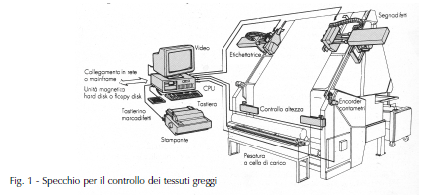© 2024 All rights reserved
Project by UsedTextilemachines.eu
Do you already have an account? Go to login Click here
Do you already have an account? Go to login Click here
We are happy to assist you
Looking for the best opportunities to satisfy the customer:
Mobile Phone: +393319020189
Working hours: 09.30 / 12.30 - 16.00 / 18.00 From Monday to Friday.
The raw fabric coming from the weaving (traditional or knitted), before being subjected to
subsequent dyeing and finishing processes, is checked at the client company on
special mirrors and other tools.
The weight, height, length of the single pieces and the number of strokes are checked a
centimeter. At the same time a control expert, supported by a computer (see figure 1),
detects in the mirror all possible defects deriving from upstream processing, mainly
defects on yarns and weaving in any case detectable visually, establishing the possibility and opportunity
to eliminate them before the subsequent processing of the fabric.

The most common defects are the following:
1. Missing or double wefts or sections of wefts;
2. Missing or double threads or sections of threads;
3. Presence of nodes;
4. Slubs or bulges on the yarn;
5. Weft tangles;
6. Lateral indents of weft sections;
7. Weaving bars;
8. Chiarelle (wefts not juxtaposed) or strabattute (wefts too juxtaposed);
9. Thread drawing errors;
10. Wire combing errors;
11. Missing stitches;
12. Regularity of the designs;
13. Color error in the warp and weave note;
14. Wefts and slow threads;
15. Vertical stripes due to warping defects on the flow rates.
If the fabric presents defects higher than the processing tolerance, the operator
communicates the defects to be removed on the pieces still to be woven directly to the weaving mill, while for
as regards the other types of defects (spinning, twisting, etc.) the employee will communicate them
to the technical office. At the end of the check, the patch is marked on the head on the reverse side, usually
with the following data: the name of the manufacturer, the progressive number (serial number) of the piece, the name
or article number and finished height. Any other data are at the discretion of the manufacturer. These
data can be imprinted on the piece by means of a hot-applied label or a special marker
indelible.
Once the defects present on the raw fabric have been detected at the control and the various types established
of intervention to be carried out, the pieces are passed to the darning department, an operation that comes
performed mainly by specialized female personnel, often belonging to centers of
mending. The assistant, based on the type of fabric to be repaired and on the recommendation of the company to whom
belongs and of the manager ("teacher"), must carry out on the fabric, with precision and professionalism,
all those interventions, diversified from each other according to the type of defect, indispensable to make it
suitable for subsequent finishing processes that may possibly be preceded
from the dry cleaners. By mending we mean all those processes that involve reconstruction
adjust the weave of the fabric, removing most of the defects indicated in the check of the
raw fabric and also replacing, if necessary, stretches of threads or irregular wefts using
spring pliers, curved scissors and needle.
By divesting we mean all those interventions that concern the elimination of babies from the tissue
knots and other impurities and small imperfections, which however do not affect the structure of the
fabric, mainly using spring clips.
After the sale of the machinery we also assist you in logistics and if desired by the customer we have technicians capable of reassembling and starting the machinery.
© 2024 All rights reserved
Project by UsedTextilemachines.eu
| Cookie | Duration | Description |
|---|---|---|
| cookielawinfo-checkbox-analytics | 11 months | This cookie is set by GDPR Cookie Consent plugin. The cookie is used to store the user consent for the cookies in the category "Analytics". |
| cookielawinfo-checkbox-functional | 11 months | The cookie is set by GDPR cookie consent to record the user consent for the cookies in the category "Functional". |
| cookielawinfo-checkbox-necessary | 11 months | This cookie is set by GDPR Cookie Consent plugin. The cookies is used to store the user consent for the cookies in the category "Necessary". |
| cookielawinfo-checkbox-others | 11 months | This cookie is set by GDPR Cookie Consent plugin. The cookie is used to store the user consent for the cookies in the category "Other. |
| cookielawinfo-checkbox-performance | 11 months | This cookie is set by GDPR Cookie Consent plugin. The cookie is used to store the user consent for the cookies in the category "Performance". |
| viewed_cookie_policy | 11 months | The cookie is set by the GDPR Cookie Consent plugin and is used to store whether or not user has consented to the use of cookies. It does not store any personal data. |
Fill out the form to contact me